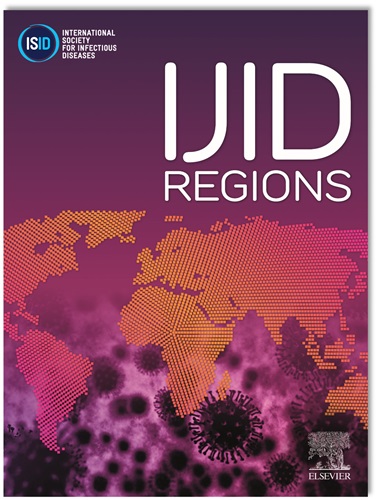布鲁氏菌病复发和局灶性并发症的危险因素:一项流行地区9年多中心研究
IF 4.3
2区 医学
Q1 INFECTIOUS DISEASES
引用次数: 0
摘要
目的:布鲁氏菌病在流行地区仍然是一种重要的人畜共患疾病,复发和局灶性并发症构成了重大的临床挑战。本研究旨在确定伊朗北呼罗珊九年期间与布鲁氏菌病复发和局灶性疾病相关的危险因素。方法:对2015 - 2024年2568例布鲁氏菌病确诊病例进行回顾性分析。根据血清学检查诊断患者,并将其分为复发组或局灶性布鲁氏菌病组。采用单因素和多因素logistic回归模型分析人口统计学、临床和流行病学变量。结果:不同地区复发率差异显著。其中,有并发症的患者复发率为12.2%,而无并发症的患者复发率为9.5%,无统计学意义,表明并发症不能预测复发。预测复发的因素包括年龄较大、女性、农业职业和特定的Coombs-Wright滴度(1/40和1/80)。局灶性并发症(4.6%)最常涉及关节炎(1.3%)和脊柱炎(1%)。局灶性布鲁氏菌病的预测因素包括秋季发病、延迟诊断≥3个月、住院和链霉素使用8-14天。结论:布鲁氏菌病复发和局灶性疾病受人口、职业、地理和治疗相关因素的影响。这些发现强调了早期诊断和优化抗生素方案在预防并发症中的重要性。本文章由计算机程序翻译,如有差异,请以英文原文为准。
Risk factors for brucellosis relapse and focal complications: A nine-year multicenter study in an endemic region
Objectives
Brucellosis remains a significant zoonotic disease in endemic regions, with relapse and focal complications posing significant clinical challenges. This study aimed to identify risk factors associated with brucellosis relapse and focal disease in North Khorasan, Iran, over a nine-year period.
Methods
A retrospective analysis was conducted on 2568 confirmed brucellosis cases from 2015 to 2024, using data from multiple centers. Patients were diagnosed based on serological tests and categorized into relapse or focal brucellosis groups. Univariate and multivariate logistic regression models were used to analyze the demographic, clinical, and epidemiological variables.
Results
Relapse rates varied significantly by region. Of these, the relapse rate was 12.2% among patients with complications, compared to 9.5% in those without, not statistically significant, indicating that complications do not predict relapse. Predictors of relapse included older age, female sex, agricultural occupation, and specific Coombs-Wright titers (1/40 and 1/80). Focal complications (4.6%) most commonly involved arthritis (1.3%) and spondylitis (1%). Predictors of focal brucellosis included autumn onset, delayed diagnosis ≥3 months, hospitalization, and streptomycin use for 8-14 days.
Conclusions
Brucellosis relapse and focal disease are influenced by demographic, occupational, geographic, and treatment-related factors. These findings underscore the importance of early diagnosis and optimized antibiotic regimens in preventing complications.
求助全文
通过发布文献求助,成功后即可免费获取论文全文。
去求助
来源期刊
CiteScore
18.90
自引率
2.40%
发文量
1020
审稿时长
30 days
期刊介绍:
International Journal of Infectious Diseases (IJID)
Publisher: International Society for Infectious Diseases
Publication Frequency: Monthly
Type: Peer-reviewed, Open Access
Scope:
Publishes original clinical and laboratory-based research.
Reports clinical trials, reviews, and some case reports.
Focuses on epidemiology, clinical diagnosis, treatment, and control of infectious diseases.
Emphasizes diseases common in under-resourced countries.

 求助内容:
求助内容: 应助结果提醒方式:
应助结果提醒方式:


